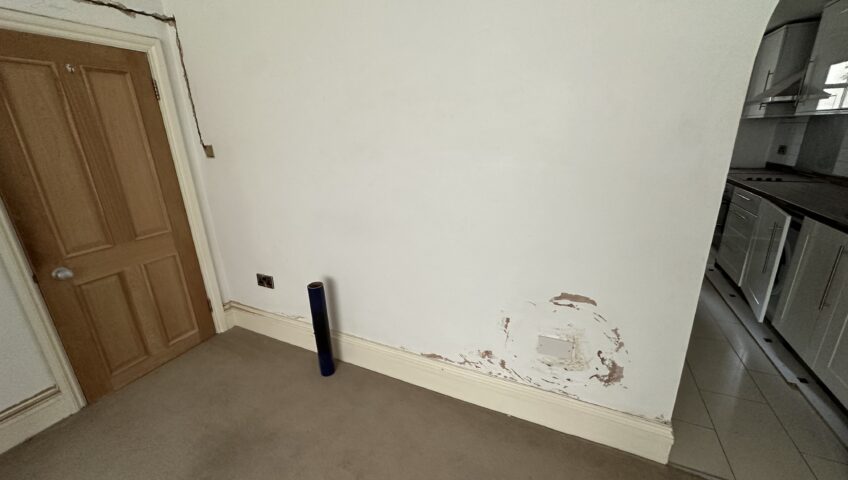
Rising Damp: A Guide for Landlords
Whether you’re a seasoned landlord or you’re managing your first buy-to-let, the condition of your property is one of the most important elements of your investment. However, from general wear and tear to appliance breakdown, a huge number of things can happen over time that require repairs or maintenance.
One of these issues, damp, can significantly impact the structural integrity of your property, and can even leave some tenants unable to live in their home. This is particularly true if your property is affected by rising damp. But luckily, there are some key steps you can take to combat rising damp once and for all. In this comprehensive guide, we’ll be discussing everything you need to know about this serious type of damp, including whose responsibility it is to get rid of it, and the treatment options you can choose from.
What is Rising Damp?
Rising damp can do some serious damage. Commonly found in older buildings, it occurs when groundwater from the soil surrounding the property moves upward, through porous building materials like bricks and mortar. As the water rises, it carries the salts and minerals present in the ground, which can lead to visible and hidden damage over time.
If your tenants notice damp patches on walls, peeling paint, a musty odour, or even visible mould growth, then it’s possible rising damp might be the culprit. In these circumstances, it’s essential to be vigilant about these signs, as unchecked rising damp can compromise the structural stability of the property and create an unhealthy living environment for your tenants.
So, What Causes Rising Damp?
To effectively manage and prevent the spread of rising damp, it’s vital to understand the root causes, as several factors can contribute to its occurrence:
- A Faulty Damp Proof Course (DPC): The DPC is a barrier built into the walls of a property to prevent the upward movement of moisture. If the DPC is damaged, improperly installed, or even absent altogether, it can lead to an ingress of rising damp. This is particularly the case for older properties, where a DPC isn’t always present or intact.
- High Groundwater Level: Properties that are built on or near waterlogged land are much more susceptible to rising damp, due to the high groundwater levels.
- Upward Water Movement: Water’s ability to move upwards through porous materials is a key factor in rising damp, and combined with higher groundwater levels, this ability can become a recipe for disaster.
- Limited Ventilation: Poor ventilation can trap moisture within the property, exacerbating rising damp issues and increasing the risk of health concerns for your tenants.
- Leaking Pipes or Gutters: A commonly overlooked cause of rising damp can be found on the outside of the property, in the form of leaking pipes or gutters – any source of excess moisture near the property’s foundation can play a big role in the spread of rising damp, so regular maintenance of the external guttering is vital.
Who Is Responsible For Treating Rising Damp In A Rental Property?
In general, landlords are responsible for maintaining the structural integrity of the property, which includes addressing rising damp issues. This means that you might be responsible for treating the damp, depending on the terms outlined in the tenancy agreement. However, it’s important to remember that tenants also have a role to play in preventing the exacerbation of damp problems, by maintaining proper ventilation and promptly reporting any signs of dampness. Regularly going out to inspect the property can also help you identify early on any potential risks of rising damp.
If the damp issue that’s affecting your property means that your tenants’ home isn’t safe for them to live in, you might be responsible for treating it under the Homes Act 2018, which relates to the fitness of property for human habitation.
Excess damp could also constitute a category 1 hazard under the Housing Health and Safety Rating System (HHSRS).
Your responsibility to free the property of damp might be clearer if the property has an existing damp-proof course, or DPC, that has developed a fault, as in most cases, landlords are responsible for repairing a DPC. However, if damp has arisen because a property doesn’t have a DPC, then the installation of one might be classed as an improvement rather than a repair, in which case it’s better to work with the tenant to consider all of the options available to treat the damp once and for all.
Treating Rising Damp: 6 Simple Steps For Landlords
Dealing with rising damp requires a systematic approach, but it’s not always easy to know where to start, or how to bring an excessive damp issue back under control. To help you do this, here are six simple steps that you can take to effectively treat rising damp, and ensure the well-being of your property and tenants:
1) Professional Assessment: It’s always best to start treating a rising damp problem by hiring a qualified professional to assess the extent of the issue. Their expertise will help identify root causes and recommend appropriate treatment methods.
2) Repair the DPC: If a faulty or absent DPC is identified as the cause of the rising damp, repairing it or installing a new one is essential. This process involves injecting a damp-proofing solution into the affected walls to create a barrier against moisture and is one of the most effective ways to tackle rising damp at its source.
3) Remove Damaged Materials: If any materials have been affected by the rising damp, such as plaster or skirting boards, they should be replaced as soon as your new DPC is in place. Not only will this prevent the problem returning by spreading up from the old materials, but it will also ensure that the underlying structure is not compromised.
4) Improve Ventilation: Make sure to address poor ventilation by installing vents or extractor fans in the property. Adequate ventilation helps prevent the buildup of moisture, and this is vital if you want to avoid rising damp.
5) Waterproofing: An often-overlooked approach to treating rising damp is waterproofing – applying a waterproofing treatment to the affected walls can provide an additional, effective layer of protection against moisture penetration.
6) Regular Maintenance: After the treatment, you should regularly monitor the property for any signs of recurring dampness. Conduct routine inspections to catch any potential issues early and ensure that treatments are quickly applied if you notice damp.
Rising damp is a difficult challenge for landlords, but one that can be tackled easily with the right knowledge and proactive measures. By understanding the causes of rising damp, knowing your responsibility as a landlord, and following a structured approach to treatment, you can ensure the long-term health and value of your rental property.
Regular maintenance and collaboration with professionals will go a long way in preventing and addressing rising damp issues. Your commitment to providing a safe and habitable living environment will support your tenants to correctly care for your property.
